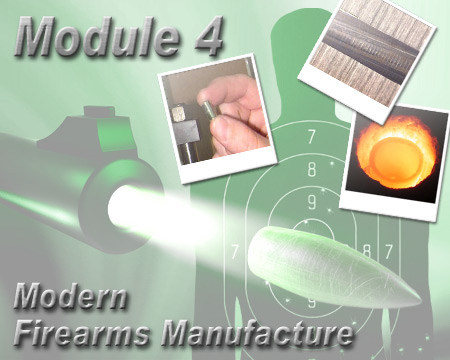Home | Glossary | Resources | Help | Contact Us | Course Map
Archival Notice
This is an archive page that is no longer being updated. It may contain outdated information and links may no longer function as originally intended.
| Author: J. Allan Jones |
| J. Allan Jones obtained a Bachelor of Science degree (1969) from Southern Methodist University and continued graduate studies there until 1971, when he joined the Dallas County (Texas) Institute of Forensic Sciences Crime Laboratory as a firearm examiner. Mr. Jones worked in that capacity until 1987, when he moved to Lewiston, Idaho, as the manager of technical publications for CCI Ammunition and Speer Bullets. He directed ballistics research for and authored Speer Reloading Manual, numbers 12, 13, and 14. Mr. Jones retired from CCI/Speer in 2007. |
Introduction
This module primarily covers the fabrication of metal components of firearms using common manufacturing technologies. Wooden, plastic, or composite stocks and grips are not discussed in this module.
Firearms manufacturing technologies are important to the firearm examiner because this is where class and individual characteristics originate. Knowledge of the manufacturing materials used provides practical information about the functional characteristics and durability of the firearm.
Objectives
At the conclusion of this module the student should be able to do the following:
- Describe traditional and current metal-forming processes, methods, and materials
- Describe the methods used for making barrels
- Define the rifling processes
- Describe the effect rifling has on bullets
- Define the contouring and crowning process
- Identify the main components of a firearm
- Identify the parts of a firearm that can produce identifiable marks for firearms identification
- Describe the firearm finishing and testing process
AFTE Knowledge and Ability Factors
| 73. | Knowledge of the historical development of firearms design |
| 74. | Knowledge of machining and finishing processes of tools, guns, barrels, breechfaces, extractors, ejectors, firing pins, and silencers (with emphasis on working surfaces and edges) and their effect on individuality. (Note: silencer marks are noted in module 11.) |
| 80. | Knowledge of sources of information regarding identification markings and serial numbering systems in firearms (including locations of serial numbers, part/assembly numbers, proof marks on firearms, and the locations of hidden numbers) |
| 98. | Knowledge of internal ballistics: ignition, pressure, function of chamber design, chamber and cartridge dimensions, headspace considerations |
| 46. | Ability to recognize: (1) those attributes or characteristics of a particular firearm design which are reflected in the fired projectiles and fired cartridge cases; and (2) nonfirearm caused toolmarks on ammunition components |
| 47. | Ability to determine the source and uniqueness of various striated and/or static marks on bullets and cartridges |
Additional Online Courses
- What Every First Responding Officer Should Know About DNA Evidence
- Collecting DNA Evidence at Property Crime Scenes
- DNA – A Prosecutor’s Practice Notebook
- Crime Scene and DNA Basics
- Laboratory Safety Programs
- DNA Amplification
- Population Genetics and Statistics
- Non-STR DNA Markers: SNPs, Y-STRs, LCN and mtDNA
- Firearms Examiner Training
- Forensic DNA Education for Law Enforcement Decisionmakers
- What Every Investigator and Evidence Technician Should Know About DNA Evidence
- Principles of Forensic DNA for Officers of the Court
- Law 101: Legal Guide for the Forensic Expert
- Laboratory Orientation and Testing of Body Fluids and Tissues
- DNA Extraction and Quantitation
- STR Data Analysis and Interpretation
- Communication Skills, Report Writing, and Courtroom Testimony
- Español for Law Enforcement
- Amplified DNA Product Separation for Forensic Analysts



